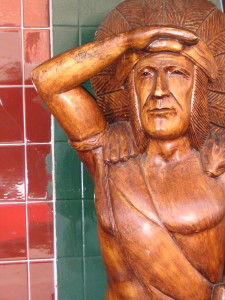
The use of decorative earrings by the indigenous people of North America dates back to ancient times. The indigenous peoples of North America have used Native American earrings for tribal identity, spirituality, ceremonies, rituals, wealth and personal adornment. Certain rituals, such as the “rite of passage” or “coming of age,” called for Native earrings as part of the ceremony; both boys and girls were adorned with Native American earrings and wore them as status symbols for the rest of their lives.
Other rituals include ceremonial dances, and dancers are decorated with special Native American earrings. Early Native Americans believed that wearing earrings would ward off bad spirits from entering through the ear, similar to the concept of the dream catcher. For many other tribes and individual artists, Native American earrings are constructed for display, art, trade or sale.
Native American Earrings: Design and Materials
Many tribes, including the Hopi and Lakota, retained their distinct aesthetic in Native American earrings even though they openly traded and borrowed ideas from neighboring tribes. The Great Plains Lakota, for instance, specialized in intricate bead work, and the Hopi of the Southwest favored metalwork and precious stones. Common designs for Native American earrings were:
- Wire loops
- Beads
- Chandlier-like dangling cones
- Chain
- Hooks
- Hairpipes
Often, various shapes and patterns would be linked together. More advanced silversmith techniques were introduced to Native American earrings by the Spanish settlers, and earrings evolved from simple loops and dangling cones to more complex patterns and stone-setting. Traditionally, materials for Native earrings are made from natural resources such as:
- Metals such as copper and silver
- Precious stones such as turquoise, amber, jet and opal
- Bones and antler
- Fresh water shells such as oyster and clam
Today, stamped trade-silver German pieces and Czech seed beads are popularly used for Native American earrings. Also popular are animal and spiritual fetishes, such as horse earrings, feather earrings, dream catchers and the Kokopelli. There are endless shapes, colors, sizes and patterns of Native earrings.
Native American Earrings and Cultural Identity
Before the arrival of Columbus, the rich cultural image of earrings was a method of communication. Without a written language, the visual manifestation of Native American earrings became a necessary means of expression, and this art form was handed down to the succeeding generations. In the post-colonial times, the need for cultural identity became a vital aspect of personal and tribal survival. Today, many Native American artists make their livelihoods from creatively upholding the ancient tradition of Native earrings.
